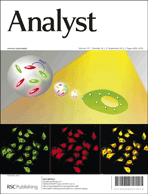An immunoreactor-based competitive fluoroimmunoassay for monitoring staphylococcal enterotoxin B using bioconjugated quantum dots
Abstract
Extensive research on avian systems has proved hens as an alternate source for polyclonal antibody generation necessary for immunosensing applications. Herein, we present the immobilization of avian antibody raised against staphylococcal enterotoxin B (SEB) and its applicability for a competitive fluoroimmunoassay technique. White leghorn hens immunized with SEB generated high affinity antibodies with a highest yield of 3.2 mg ml−1 having affinity constant of 0.976 × 1010 M l−1. A competitive fluoroimmunoassay format was developed comprising CdTe557 as a fluorescence detector for monitoring SEB, a bacterial super-


 Please wait while we load your content...
Please wait while we load your content...